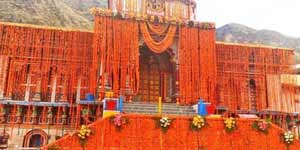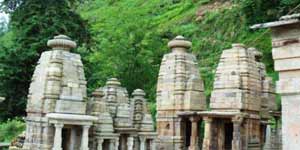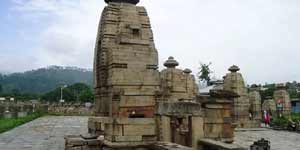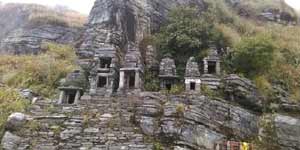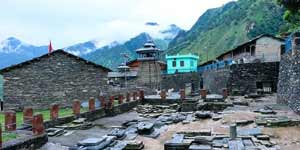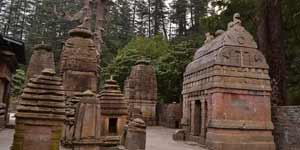
Jageshwar Temples
Jageshwar Dham is the Shiva’s abode as Jageshwar or Nagesh in the wooded highlands of Uttaranchal. I had seen images of stone temples of the Kumaon region of Uttaranchal and always wanted to visit them. What I had not expected is a whole temple town dedicated to Shiva temples. We reached the town from Almora after a short drive of 35 km that goes through the tall pine trees. As we got closer to the town, the pine trees gave way to the Deodar trees and the valley wore a dark green look.
A few KMs short of the town we got the first glimpse of stone temples here. A small group of temples was standing across a small stream separating the hill and the road. After a km or so, we found ourselves in a small valley surrounded by a thick cover of dark green and tall deodar trees. On one side of the road is the KMVN Tourist Rest House and on other the main temple Complex. In between, there is a small building with a lovely doorjamb. This is the ASI site museum – a treasure I would soon discover.
Jageshwar Temple
The temple complex is like a small nest in the middle of tall and thick Deodar trees along the bend of a river.
A few houses with intricately carved wooden doors and windows are scattered on the hill facing the temple complex. The lane opposite the temple has a small market and that is all. You see a complete town in a narrow valley that has an ancient temple complex with no less than 130 temples, a village, it’s market, a river, and a jungle. All in one frame. You wonder how it would be to live here – like living in an extended family home where a lot of guests come visiting. Or would you live as caretakers of the ancient temples, after all the life here revolves around the temples? How it would be to see the snowfall and add a layer of white cover to the landscape. There was no end to the scenarios that played in my mind.
History
History tells that during the 4th and 5th centuries AD, when the Gupta emperors held sway, the Kumaon hills were being governed by an independent dynasty of Katyuri kings. They selected this site for building temples. The temples originally constructed during the Gupta period were renovated by the rulers of the Ghand dynasty in the 7th century AD. Numerous temples were constructed or restored during the Gurjara Pratihara era and also in the 15th and 16th centuries.
The Mahamrityunjaya temple seems to be the oldest of all the temples and dates back to the 8th century AD. The temples of Surya, Navagraha and Neelkantheshvara are of late Katyuri age. It is said that originally four hundred temples existed here, of which only about one hundred and eight have survived.
Uttarakhand Monuments
The state of Uttarakhand attracts big crowds from almost every part of the country and outside. Both from historical and religious points of view, the state has a prominent place in the country. The state's rich history has been gifted with several monuments dispersed throughout. Past rulers like the Pandavas, Kauravas, Guptas and the British all erected monuments during their reigns. Today, Uttarakhand is visited in great number for its high number of monuments, which only increase the state's glory.
You'll see a huge number of historical as well as religious monuments across the state. Temples form an important part of the monumental treasure of the state. These religious monuments also feature some of the best temple architecture in India. Apart from Hindu temples, the state also features many Tibetan Buddhism monuments that are a must visit for travellers.
List of Uttarakhand Monuments
If you are a keen lover of monuments, the state of Uttarakhand welcomes you. Given below is a list of all the religious and historical monuments that you can plan to visit during your holidays in the state. If you want more details on these monuments or want to plan a tour, feel free to get in touch with our travel advisors who are waiting to hear from you.
- Badrinath group of temples
- Bandeo Temple
- Gujardeo Temple
- Kacheri group of temples
- Kutumbari Temple
- Maniyan group of temples
- Mritunjaya group of temples
- Ratan Deo Shrines Surya Temple
- Dandeshwar Temple
- Chandi-ka-Temple
- Jageshwar Temple
- Kuber Temple
- Nanda Devi
- Nava-grah Shrine
- Pyramidal Shrine
- Patal Bhubaneshwar Caves
- Kalinga Monuments
- Rudranath Temple


